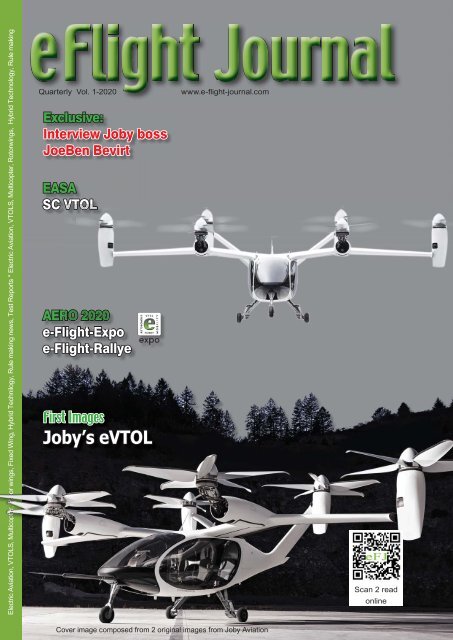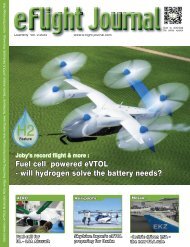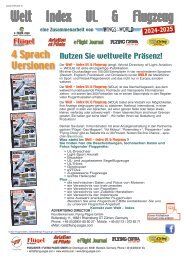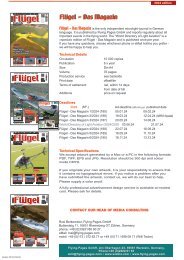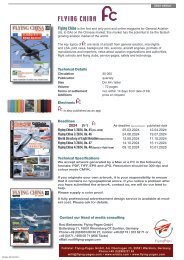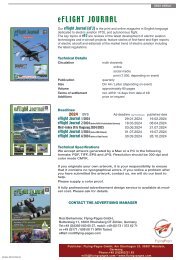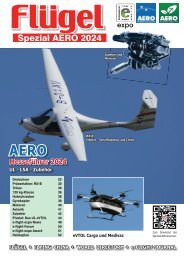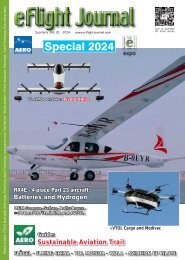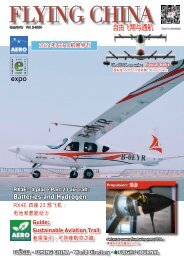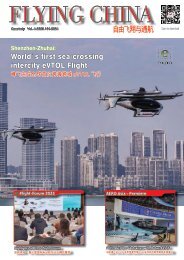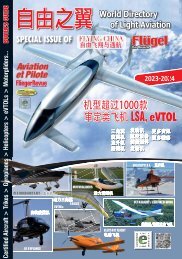E-flight-Journal 1 2020 Version2
The second Version(before Print) of the first E flight Journal of 2020. Some parts still missing: A magazine for E-flight E-VTOL etc
The second Version(before Print) of the first E flight Journal of 2020. Some parts still missing: A magazine for E-flight E-VTOL etc
You also want an ePaper? Increase the reach of your titles
YUMPU automatically turns print PDFs into web optimized ePapers that Google loves.
Electric Aviation, VTOLS, Multicopter, te<br />
Rotor or wings, Fixed Wing, Hybrid Technilogy, Rule making news, Test Reports * Electric Aviation, VTOLS, Multicopter, Rotorwings, Hybrid Technology, Rule making<br />
Quarterly Vol. 1-<strong>2020</strong><br />
Exclusive:<br />
Interview Joby boss<br />
JoeBen Bevirt<br />
EASA<br />
SC VTOL<br />
AERO <strong>2020</strong><br />
e-Flight-Expo<br />
e-Flight-Rallye<br />
First Images<br />
Joby’s eVTOL<br />
www.e-fl ight-journal.com<br />
Scan 2 read<br />
online<br />
Cover image composed from 2 original images from Joby Aviation
e Visions<br />
Powering<br />
the Future<br />
50 -70 kW 200 kW<br />
260 kW 2.000 kW<br />
With air traffic continuously rising,<br />
new solutions are needed to increase<br />
efficiency and limit environmental effects.<br />
Rolls-Royce is developing electric<br />
propulsion systems to power a more<br />
sustainable future of aviation and new<br />
mobility concepts, with power classes<br />
ranging from less than one hundred<br />
to several thousand kilowatts.<br />
rolls-royce.com<br />
2<br />
PIONEERS OF POWER<br />
Meet us at the eFlight Forum China<br />
in Shijiazhuang on October 16-17.
editorial<br />
The Races are on<br />
Since Uber introduced its elevate concept eVTOLs and Urban<br />
Air Mobility are in the public discussion. In the last years several<br />
Manufacturers made their first <strong>flight</strong>s and started test-programs.<br />
Most recently, Joby Aviation’s 590 Million Dollars new financing<br />
cought the headlines around the world in the third week of<br />
January <strong>2020</strong>. Other companies from the eVTOL sector will likely<br />
follow. Some others like Wisk with its shareholders Boeing and<br />
Google do not need much external funding. Undoubtly the funding<br />
is heavily influencing who will be the first one who can certify<br />
an eVTOL and put it into operations. But there are more races<br />
at the moment going on than just the one of the manufacturers of<br />
the airframes.<br />
There is also the competition of the certification authorities on<br />
the certification matters which is as important for the enabling of<br />
the operations as the eVTOL design and production. As of today<br />
the approaches which FAA and EASA has been taken are fairly<br />
different. EASA released and explained its views of its SC-VTOL<br />
at the EASA Rotorcraft Symposium in Cologne / Germany last<br />
December. Besides EASA and FAA, the Chinese regulator CAAC<br />
has its own approach as well.<br />
Another competition is happening between the Countries for test<br />
Areas and also the potential early adopter cities is on. Will it be<br />
Dallas, Singapore, LA or Paris or a totally different City which can<br />
offer the first UAM service? In the background there is another<br />
field which also has to be done before the service can start: the<br />
development of a common air traffic system for the eVTOLs which<br />
has to interact with the conventional air traffic system of airliners<br />
and general aviation as well with the growing unmanned sector.<br />
In order to make the UAM dream come true, all the factors mentioned<br />
above have to be addressed. But as we can see, global efforts<br />
are being made. The races are on and it is exciting to see<br />
who will be the first winner. Who will you put your money on?<br />
Willi Tacke<br />
Xin Gou<br />
1 / <strong>2020</strong> e Flight <strong>Journal</strong> 3
ot<br />
p<br />
te<br />
r,<br />
Content / Imprint<br />
Electric Aviation, VTOLS, Multicopter, t Rotor or wings, Fixed Wing, Hybrid Technilogy, Rule making news, Test Reports * Electric Aviation, VTOLS, Multicopter, Rotorwings, Hybrid Technology, Rule making<br />
Quarterly Vol. 1-<strong>2020</strong><br />
Exclusive:<br />
Interview Joby boss<br />
JoeBen Bevirt<br />
EASA<br />
SC VTOL<br />
AERO <strong>2020</strong><br />
e-Flight-Expo<br />
e-Flight-Rallye<br />
First Images<br />
Joby’s eVTOL<br />
www.e-fl ight-journal.com<br />
Scan 2 read<br />
online<br />
3 • Editorial<br />
The Races are on<br />
6 • eNews around the world<br />
12 • Interview with<br />
Cover image composed from 2 original images from Joby Aviation<br />
Cover image composed<br />
from 2 original images from<br />
Joby Aviation<br />
JoeBen Bevirt / Joby Aviation<br />
16 • Vienna Conference:<br />
The Future of Transportation<br />
We the e Flight <strong>Journal</strong> (e FJ) founders<br />
are a team of aviation journalists and<br />
enthusiasts who created Flying-Pages.<br />
Publishing several aviation publications<br />
around the world. It started with the interest<br />
in electric flying in 2009. We cofounded<br />
the e-Flight-Expo in Friedrichshafen/Germany<br />
as part of the AERO,<br />
and established it as the largest show<br />
for electric aviation worldwide.<br />
The e FJ is supported by the GAMA<br />
EPIC committee, Rolls-Royce, Rotax<br />
and many others.<br />
World Conference<br />
22 • 3rd e-<strong>flight</strong> Forum in China:<br />
Certification is the Key<br />
30 • eVTOL summary for 2019<br />
36 • SC VTOL -The European way<br />
e Flight <strong>Journal</strong><br />
www.flying-pages.com<br />
Publisher, Flying-pages GmbH, Buttersteig 11,<br />
D-16831 Rheinsberg OT Zühlen<br />
• phone: D-033931/80 60 27, Fax.: D-030/34 70 91 24<br />
• info@flying-pages.com • www.flying-pages.com<br />
ADVERTISING<br />
Worldwide Willi Tacke, • phone :+49 (0)8841 / 487 515,<br />
mob:+49 (0)171 69 808 71, fax:+49(0)8841 / 496 012,<br />
US Cell: +1 920 385 8495 • willi@flying-pages.com<br />
Germany & other Countries, Rosi Berkemeier<br />
• phone: +49 (0)33931/80 60 27 • Fax +49 (0)30 / 3470 9124<br />
• rosi@flying-pages.com<br />
USA, Bettina C. Larrarte • phone.: +1 970 310 1410<br />
• bc@flying-pages.com<br />
EDITORIAL<br />
Robby Bayerl, Marino Boric, Greg Bowls, René Coulon, Dimitri Delemarle, Jan<br />
Fridrich, Mike Friend, Xin Guo, Martin Hardung, Dan Johnson, Klaus Köhmstedt,<br />
Germán Larrarte, Werner Pfändler, Peter Raab, Jan Otto Reimers, Torkell<br />
Saetervade, Christian Tacke, Julia Tacke, Willi Tacke, Dave Unwin, Qinyin<br />
Zhang, Markus Villinger, Jean-Marie Urlacher (Photo).<br />
Managing Editor, Design: Bettina Cosima Larrarte<br />
Technical Proofreader/USA: Renée Larrarte<br />
Online: Achim Holzmann<br />
© 2018 Flying-Pages GmbH. No part of this publication may be reproduced,<br />
stored in a retrieval system, or transmitted in any form, or by any means,<br />
electrical, mechanical, photocopying, recording, or otherwise, without the prior<br />
permission of the copyright owner.<br />
DISCLAIMER<br />
This publication consists largely of information supplied by traders and<br />
manufacturers. Flying-Pages GmbH and its associates do not take any<br />
responsibility for the data, facts, wording, addresses, prices and spelling of<br />
the items published and do not claim the market survey to be complete. The<br />
publisher has made every effort to ensure its accuracy and completeness, and<br />
has queried many facts during its compilation, but cannot be held responsible<br />
for errors or omissions, or for any problems arising from them, or for the use<br />
to which the information is put.<br />
4 e Flight <strong>Journal</strong><br />
1 / <strong>2020</strong>
Cover News Story<br />
Hyundai and Uber unveiled UAM solution<br />
Hyundai Motor Company and Uber Elevate displayed a<br />
complete urban air mobility (UAM) electric vertical takeoff<br />
& landing (eVTOL) concept vehicle called S-A1, autonomous<br />
pods, and a hub ecosystem at the Consumer Electronics<br />
Show (CES) in January <strong>2020</strong>. Hyundai also revealed<br />
its Purpose Built Vehicle (PBV) concept, capable<br />
of adapting to specific lifestyle needs of passengers and<br />
reducing time wasted on congested highways. Hyundai<br />
is the first Uber Elevate partner with automotive manufacturing<br />
capabilities to mass produce such electric aircraft<br />
and autonomous pods. S-A is designed for a cruising<br />
speed up to 180 miles/hr (290 km/hr), a cruising altitude<br />
of around 1,000-2,000 feet (300 - 600 mt) above ground,<br />
and to fly trips up to 60 mile (100 km). Hyundai will produce<br />
and deploy the S-A1 using its automotive manufacturing<br />
capability. Hyundai set up a dedicated UAM department<br />
and recruited Jaiwon Shin, the former NASA<br />
associate administrator, as the Head of Hyundai’s Urban<br />
Air Mobility (UAM) Division last year.<br />
CityAirbus Makes First Untethered Flight<br />
Airbus’ all-electric, four-seat multicopter demonstrator,<br />
CityAirbus, made its first untethered <strong>flight</strong> in December<br />
2019 in Donauwörth, Germany. Eight pitch rotors are<br />
powered by eight specially designed Siemens SP200D<br />
direct-drive 100 kW units relying on four 140 kW batteries<br />
developed by Airbus’ Defense<br />
and Space arm. The<br />
CityAirbus will carry up to four<br />
passengers with a cruise speed<br />
of 75 mph (120 km/h). The model<br />
currently will have 15 minutes<br />
of <strong>flight</strong> time. The vehicle is designed<br />
to fly autonomously. The<br />
four carbon fiber ducted co-axial<br />
propeller configuration will contribute<br />
to a low acoustic foot-<br />
print. Each duct provides 881 lb (400 kg) of thrust for a<br />
payload of up to 551 lb (250 kg).The first unmanned tethered<br />
<strong>flight</strong> of CityAirbus took place in May 2019 at the Airbus<br />
Helicopters <strong>flight</strong> test facility in Donauwörth, Bavaria,<br />
Germany.<br />
6 e Flight <strong>Journal</strong><br />
1 / <strong>2020</strong>
News<br />
D3: New German startup develops<br />
ATM for Drones and eVTOLs<br />
The problem is clear, next to Certification and the developing<br />
of the physical and electrical ground infrastructure<br />
the Challenge for bringing eVTOLs into service is developing<br />
an Air Traffic management (ATM) - system that<br />
connects the conventional ATM-System for the airliners<br />
and GA together with the new vertical traffic of drones<br />
and manned eVTOLs. D3 is the name of a new German<br />
start-up from Munich which wants to solve this problem.<br />
Several eVTOL manufacturers like Volocopter or Embraer<br />
and also the taxi ride share company UBER are<br />
working on such a system; buts it’s unlikely that the system<br />
from one of the competitors can be the system for<br />
everybody. Cities and countries probably will look for a<br />
system from a neutral developer which will be open for<br />
all manufacturers.<br />
This is the part of the market where D3 searches his<br />
place. “We have a strong team of developers and programmers“<br />
says CEO Corvin Huber, ”and we see an<br />
openness as well on the sides of the manufacturers and<br />
the operators and countries”.<br />
European Helicopter Association and EASA to launch<br />
EUROPEAN ROTORS fair in November <strong>2020</strong><br />
The European Helicopter Association (EHA) and the European<br />
Union Aviation Safety Agency (EASA) will organize<br />
the first EUROPEAN ROTORS fair in Cologne in November<br />
10-12 <strong>2020</strong>. It will also integrate the renowned<br />
EASA Rotorcraft and VTOL Symposium. The fair will include<br />
both conventional helicopter and fast-growing eV-<br />
IF YOU ARE ROTORS<br />
WE GOT IT!<br />
Exhibitor Information<br />
www.europeanrotors.eu<br />
Nov. 10 – 12, <strong>2020</strong><br />
Koelnmesse | Germany<br />
TOL. The venue for EUROPEAN ROTORS will be Hall 8 and the Congress<br />
Centre North of Koelnmesse, Germany. The motto of EUROPEAN<br />
ROTORS <strong>2020</strong> is “It’s for everyone”. The market leaders Airbus, Bell,<br />
Leonardo and Safran are supporting the new format both through their<br />
presence as exhibitors and with an advisory function. The fair aims to<br />
organised by<br />
in cooperation with<br />
offer operators, manufacturers, aviation authorities, the supporting industry,<br />
mechanics, pilots, customers and suppliers<br />
the opportunity to network and also to be informed<br />
on state-of-the-art equipment and services, and direct<br />
exchange with manufacturers, operators, Approved<br />
Training Organisations (ATOs) and maintenance<br />
organisations. Visitors will additionally have<br />
the chance to discuss present and future regulations<br />
as well as to participate in dedicated training.<br />
The three-day event will also include the renowned<br />
EASA Rotorcraft and VTOL Symposium. Beside the<br />
organizers, the service partner is Messe Friedrichshafen,<br />
an experienced exhibition and fairs company,<br />
which also stages the established aviation show<br />
AERO Friedrichshafen. Further information, including<br />
opening times and prices, is available at www.europeanrotors.eu.<br />
1 / <strong>2020</strong><br />
e Flight <strong>Journal</strong><br />
7
Cover News Story<br />
WISK wants to pursue full autonomous <strong>flight</strong> from the<br />
beginning<br />
The joint venture between Boeing and Larry Page-backed<br />
Kitty Hawk wants to bypass pilots in its WISK eVTOL and<br />
fly fully autonomously at the beginning. WISK CEO Gary<br />
Gysin confirmed in a recent interview with eVTOL.com<br />
that WISK are going direct to autonomy. Instead of taking<br />
the step-by-step approach like many eVTOL are doing,<br />
WISK wants to fly autonomously on its two-seat eV-<br />
TOL. This bold approach is understandable considering<br />
that WISK’s current model has only two seats and it only<br />
makes commercial sense to devote both seats to paid<br />
passengers. However this means that WISK will have to<br />
pursue certification for autonomous filght at the beginning.<br />
According to WISK’s chief marketing officer Becky<br />
Tanner, WISK has made more than 1,000 unmanned test<br />
<strong>flight</strong>s.<br />
Terrafugia unveiled new<br />
eVTOL design<br />
Terrafugia has recently made a sub-scale prototype<br />
which first flew in mid-December 2019 in China to validate<br />
the design of the new TF-2A all electric vertical takeoff<br />
and landing (eVTOL) aircraft. According to Terrafugia,<br />
TF-2A has a wingspan of 4.5 meters (14.8 ft), maximum<br />
take-off weight of 60 kg (132 lb), and a cruising speed of<br />
about 100 kilometers per hour (62 mph). The TF-2A eV-<br />
TOL aircraft will have eight (8) lift-propellers and one (1)<br />
rear pusher-prop for forward <strong>flight</strong>, a cruise speed of up<br />
to 180 km/h (112 mph), a maximum range of 100 km (62<br />
miles), capacity for two (2) passengers and luggage, a<br />
maximum payload weight of 200 kg (440 lb). The subscale<br />
model has a MTOW 60kg and can cruise up to<br />
100km per hour.<br />
8 e Flight <strong>Journal</strong><br />
1 / <strong>2020</strong>
Cover News Story<br />
UK granted £9m to develop<br />
hybrid electric propulsion<br />
system for Islander airplane<br />
Image credit: Frank Schwichtenberg<br />
A consortium of British business has received a £9m<br />
grant from the government to help design, manufacture<br />
and integrate a hybrid-electric propulsion system into a<br />
nine-seater Britten-Norman (B-N) Islander aircraft, which<br />
is typically used on short <strong>flight</strong>s such as island-hopping.<br />
The Project Fresson consortium brings together: Rolls-<br />
Royce, which will supply the power management system;<br />
the Denis Ferranti Group, which will supply the<br />
electric motors; Delta Motorsport, providing the battery<br />
packs; WMG (University of Warwick), which will perform<br />
battery testing; Cranfield Aerospace Solutions (CAeS),<br />
an aircraft integrator specialising in green commercial<br />
aviation; and the plane-maker, Britten-Norman. CAeS’<br />
parent Cranfield University will research key technologies<br />
during the 30-month project.<br />
The £9m grant is being provided through the ATI Programme<br />
– a partnership of the Aerospace Technology<br />
Institute (ATI), the Department for Business, Energy<br />
& Industry Strategy, and Innovate UK, which is aimed<br />
at maintaining and expanding the UK’s position in civil<br />
aerospace design and manufacturing.<br />
EASA released Proposed<br />
Electric Propulsion Units for<br />
certified aircraft regulation<br />
On January 7, <strong>2020</strong> EASA released “Proposed Electric<br />
Propulsion Units for CS-22 Sailplanes and Powered Sailplanes,<br />
CS-LSA Light Sport Aeroplanes, CS-VLA Very<br />
Light Aeroplanes and CS-23 Normal, Utility, Aerobatic<br />
and Commuter Aeroplanes up to Level 1”.<br />
10 e Flight <strong>Journal</strong><br />
1 / <strong>2020</strong>
Cover Market e Founder Story Watch<br />
JOBY AVIATION<br />
+ 590 MILLION US$<br />
JoeBen Bevirt started his company Joby<br />
Aviation back in 2009, but already thought<br />
about developing an eVTOL long before.<br />
In 2015 the first designs were made which<br />
inspired many others to follow. After that<br />
it was very quite around the Californian<br />
Company and you only heard about it<br />
when Intel and Toyota invested in them<br />
in 2018. On January 17th , <strong>2020</strong> the next<br />
round of investment was published and<br />
they are in the focus again: with a record<br />
of 590 Million Dollars from investors from<br />
the c-round they are definitely the talks<br />
in the global eVTOL towns and beyond.<br />
Although still many of the developments<br />
continue secret, eFlight <strong>Journal</strong> had the<br />
chance to ask JoeBen Bevirt (46) some<br />
questions in an exclusive Interview:<br />
eFJ: When did you start the company?<br />
JoeBen Bevirt: In 2009.<br />
eFJ: What is your formation?<br />
JoeBen Bevirt: Master in Mechanical Engineering<br />
Design of Stanford University.<br />
eFJ: When did you have the first idea<br />
for an eVTOL?<br />
JoeBen Bevirt: First time in 1992.<br />
eFJ: When did the first Prototype Fly?<br />
JoeBen Bevirt: We are not commenting<br />
on our historical testing efforts.<br />
EFJ: How many seats will have your<br />
first Product on the market?<br />
JoeBen Bevirt: 4 seats and a pilot.<br />
12 e Flight <strong>Journal</strong><br />
1 / <strong>2020</strong>
e Founder<br />
H<br />
eFJ: How many Prototypes have been Flying?<br />
JoeBen Bevirt: We are not commenting on our historical 2009-2014<br />
testing efforts.<br />
Joby Aviation is founded in 2009 to revolutionize<br />
eFJ: How many <strong>flight</strong> hours you have with the different<br />
prototypes?<br />
Over the following years, Joby develops simulta-<br />
personal transportation with electric VTOL aircraft.<br />
JoeBen Bevirt: We are not disclosing details about our neous capabilities in rapid prototyping, advanced<br />
testing at this time.<br />
carbon fiber structures, high-fidelity aerodynamics<br />
analysis, and electric motor design. Through<br />
eFJ: Wisk (before Kitty Hawk & Cora) says that their<br />
eVTOL will never fly piloted but autonomous from the analysis and subscale <strong>flight</strong> tests, Joby designs<br />
beginning – will Jobys first transport <strong>flight</strong>s be piloted?<br />
configurations.<br />
and evaluates many different electric VTOL aircraft<br />
JoeBen Bevirt: Our aircraft will have a pilot.<br />
EFJ: What do you think: In which country the first eV- 2014-2017<br />
TOL will be certified? And where will we see the first Joby settles on the optimal configuration and begins<br />
developing technology demonstrators. Ear-<br />
commercial service?<br />
JoeBen Bevirt: We are not in a position to guess the answer.<br />
We are working collaboratively with several regulascale<br />
test <strong>flight</strong>s throughout the hover, transition,<br />
ly subscale testing followed by hundreds of fulltory<br />
agencies.<br />
and wingborne <strong>flight</strong> regimes prove the design is<br />
eFJ: In which year?<br />
reliable, quiet, efficient, and well-suited to the air<br />
JoeBen Bevirt: We are targeting initial commercial deployment<br />
by 2023.<br />
taxi mission.<br />
eFJ: You think there will be any private eVTOLs or will 2017-Present<br />
the aircraft only be operated by operators ?<br />
Joby develops and begins <strong>flight</strong> testing production<br />
prototypes on the path towards polished<br />
JoeBen Bevirt: We expect to launch air taxi operations<br />
through either (1) our own rideshare service, or (2) in products ready for certification, production, and<br />
partnership with Uber and/or other rideshare companies. operation. Joby opens its formal certification program<br />
with the FAA.<br />
eFJ: Who do you think is your strongest competitor?<br />
JoeBen Bevirt: Competition is good; it’s a new market,<br />
new behaviour on the part of consumers, new thinking JoeBen Bevirt: We don’t comment on our suppliers.<br />
in terms of regulation. It requires innovation - competition<br />
helps to raise the bar. But: We don’t comment on our is this being continued?<br />
eFJ: Toyota did also show their own eVTOL design -<br />
competitors.<br />
JoeBen Bevirt: We can’t comment on Toyota’s plans.<br />
eFJ: How many people work at Joby at the moment? eFJ: We heard that you are also establishing part of<br />
JoeBen Bevirt: We don’t disclose our headcount. the manufacturing in Europe - is this correct ? If so,<br />
eFJ: When will Joby for the first time fly in public? in hich countries and which parts? Are you disclosing<br />
this info?<br />
JoeBen Bevirt: We are not disclosing details about our<br />
future plans.<br />
JoeBen Bevirt: We are not disclosing these details at this<br />
eFJ: Which cities are in the race?<br />
time.<br />
JoeBen Bevirt: We are not disclosing details about our eFJ: Are you also considering certification with<br />
future plans.<br />
EASA?<br />
eFJ: Have you ever thought in the beginning that your JoeBen Bevirt: Joby has been working with the FAA for<br />
company would reach this hight?<br />
several years and began a formal certification program<br />
JoeBen Bevirt: We always believed our dream would become<br />
a reality.<br />
safety of the design and typically takes 3 to 5 years.<br />
in 2018. The design certification process assures the<br />
eFJ: Joby has suppliers from around the world - I a. Joby plans to establish a Part 135 commercial aircraft<br />
suppose also from Europe and Japan?<br />
operation with the FAA to assure that once the design is<br />
1 / <strong>2020</strong><br />
e Flight <strong>Journal</strong><br />
13
Cover e Founder Story<br />
certified, commercial operations can begin promptly afterwards.<br />
b. Joby continues to evaluate key markets around the<br />
world and will pursue certification from the relevant regulatory<br />
authorities as required. Joby is in discussion with<br />
a number of international regulators regarding the commercial<br />
operation of its aircraft.<br />
c.Joby will establish commercial aircraft operations in<br />
each country of operation and the best practices from<br />
each of these markets will be used to inform the overall<br />
safety of Joby’s aircraft operations around the world.<br />
eFJ: Why end up with a car company - and a Japanese<br />
car company?<br />
JoeBen Bevirt: Toyota Motor Corporation is a visionary in<br />
terms of sustainability and mobility.<br />
We have a shared vision of future modes of transportation.<br />
eFJ: What made Joby eVTOL design unique?<br />
JoeBen Bevirt: Joby Aviation’s aircraft is designed for<br />
four passengers plus a pilot. It can travel more than 150<br />
miles on a single charge, is 100 times quieter than conventional<br />
aircraft during takeoff and landing, and is nearsilent<br />
in flyover.<br />
eFJ: With the speculation on the market: the value of<br />
Joby is estimated between 700 Million US$ and over<br />
1 Billion US$ – Where do you see the value?<br />
JoeBen Bevirt: We don’t comment on our valuation.<br />
eFJ: Thank you so much. 4<br />
Joby Aviation<br />
- the<br />
team<br />
14 e Flight <strong>Journal</strong><br />
1 / <strong>2020</strong>
Expos / Fairs<br />
VIENNA CONFERENCE<br />
DIVERSIFIED & INTERCONNECTED<br />
eVTOL and UAM was<br />
undoubtedly a highlight<br />
of the conference<br />
as the introduction<br />
video played at<br />
the opening.<br />
A REPORT OF<br />
“THE FUTURE OF TRANSPORTATION<br />
WORLD CONFERENCE”<br />
It’s crowded. It’s distracting, in a good way. “The Future of Transportation<br />
World Conference” was held for the second time in Vienna<br />
last December. You had to choose from 9 sessions (called streams in<br />
the conference brochure) and over 170 speakers, all packed into two<br />
days, to attend. I can assure you that’s not an easy task.<br />
16 e Flight <strong>Journal</strong><br />
1 / <strong>2020</strong>
Expos / Fairs<br />
Among the myriad of presentations, there were also a<br />
glorious social night on the first day with fancy performances,<br />
free beers and a fair sized exhibition, which<br />
makes scheduling work even harder (especially during<br />
the morning sessions on the second day). Then you<br />
know you are at the right place because this is where<br />
you can listen to the presentations and bump into people<br />
from almost all sectors of transportation and a little<br />
beyond, from micro mobility, to urban air mobility (UAM)<br />
and eVTOL, to AI, 5G connectivity, electric distribution<br />
and anything in between. It’s very convenient to jump<br />
from a presentation about 5G to another one about road<br />
freight management in the next room. You just wish you<br />
could have a twin brother or sister, or even better a triplet.<br />
As Laila Hareb, the advisor to the General Civil Aviation<br />
Authority of UAE, presented, UAE is certainly an<br />
interesting place to explore for any transportation innovation<br />
entrepreneurs. UAE is one of the first countries<br />
in the world to approve for eVTOL trial <strong>flight</strong><br />
and has been working with EASA for eVTOL certification.<br />
Among the diversification of all the topics, this conference<br />
clearly illustrated the strong interest in and prospect<br />
of UAM which is becoming part of the larger picture<br />
of electric mobility and urban transportation. One of the<br />
main reasons is that unlike conventional aircraft designs,<br />
eVTOL and UAM application shares technology and infrastructure<br />
with electric mobility such as autonomous<br />
control, digital connectivity, electric distribution, battery<br />
Mike Hirschberg of Vertical Flight Society made a good summary of eVTOL evolution. As of today there have<br />
been 231 eVTOL designs listed in VFS’s database.<br />
1 / <strong>2020</strong><br />
e Flight <strong>Journal</strong><br />
17
Cover Expos Story / Fairs<br />
and so on. In this sense, UAM may only prevail if it becomes<br />
part of the urban electric mobility infrastructure.<br />
Therefore, eVTOL and UAM fit in such conference right<br />
at home.<br />
Kaydon Stanzione, the CEO of Jaunt Air Mobility, listed the<br />
reasoning for the emerge of eVTOL and UAM application.<br />
Jaunt Air Mobility became Uber Elevate partner last June and<br />
has been working with BAE and Honeywell on their unique eV-<br />
TOL design with slow rotor technology.<br />
The close collaboration between UAM and urban transportation<br />
and other digital technologies also draw the attention<br />
of the transportation industry. It’s not a coincidence<br />
that the beginning scene and a large part of the<br />
promotional video of the conference was about aviation<br />
and a showcase of eVTOL and UAM. The first session of<br />
the conference is “urban and inter-urban eVTOL Air mobility”<br />
and it’s packed with audiences from many different<br />
backgrounds. I met a guy from a Japanese logistic<br />
management company and an American kit plane builder<br />
who wants to buy a demonstration ride in an eVTOL,<br />
to just give you an example.<br />
The two-day UAM sessions were moderated by Mike<br />
Hirschberg, the Executive Director of Vertical Flight Society<br />
(VFS), and Darrell Swanson, the Director of Swanson<br />
Aviation Consultancy respectively. Speakers in UAM<br />
sessions included representatives from Roland Berger,<br />
Jaunt Air Mobility (Uber Elevate partner), Volocopter,<br />
LIFT Aircraft, Porsche Consulting, Rohde & Schwarz, to<br />
name a few.<br />
Darrell Swanson of Swanson Aviation Consultancy was one of<br />
the few speakers at the conference mentioning electric fixedwing<br />
airplanes’ application in the user case of short-haul intercity<br />
transportation, as indicated in his slide of distributed aviation<br />
Balazs Kerulo of LIFT Aircraft illustrated the complexity of safety<br />
consideration and possible solutions in eVTOL design. LIFT<br />
is going to roll out experience ride across the US beginning in<br />
<strong>2020</strong> in LIFT eVTOL which is compliant with Part 103 ultralight<br />
rule.<br />
Mike made a very good summary of the eVTOL evolution<br />
in his opening speech. VFS has been doing profound<br />
work in eVTOL update and analysis. The eVTOL database<br />
that VFS has built and offers for public use is the<br />
first stop for anyone interested in eVTOL. As of today,<br />
there have been 231 eVTOL designs listed in VFS’s database,<br />
a significant increase from last year. Despite the<br />
strong interest in eVTOL and UAM from investors, designers<br />
and entrepreneurs, certification and operation regulation,<br />
infrastructure and social acceptance remain to be<br />
the main barriers for eVTOL’s commercial deployment. In<br />
the efforts of the industry coalitions such as GAMA and<br />
VFS and the e-<strong>flight</strong>-forum organized by Flying Pages in<br />
China, regulators in major markets have been working<br />
on a solution for eVTOL certification and even trial operation.<br />
EASA and the Chinese regulator CAAC appear to be<br />
spearheading policy-making. EASA released the “Special<br />
Condition for Small-Category Vertical Take-Off and<br />
Landing (VTOL) Aircraft” (SC-VTOL) last July which is a<br />
big and the first such achievement of the regulator. CAAC<br />
has released several regulations concerning eVTOL and<br />
large drones in 2019. CAAC has permit trial operation of<br />
eVTOL in designated routes in several cities in China.<br />
18 e Flight <strong>Journal</strong><br />
1 / <strong>2020</strong>
Cover Expos Story / Fairs<br />
Simon Whalley of Skyports gave an insightful presentation of<br />
their Vertiport design. Skyports has partnered with Volocopter<br />
to build a showcase Vertiport in Singapore last October.<br />
That said, detailed certification rules remain unclear as<br />
of today and thus is still a main subject at the presentation<br />
and panel discussion at the conference. One of the<br />
solutions according to the current rules is to make eV-<br />
TOL compliant with Part 103 ultralight rule in the US and<br />
in China where both regulators do not require any type<br />
certificate of Part 103 ultralight. There have been several<br />
such efforts including Kitty Hawk eVTOL (just terminated)<br />
and LIFT. Balazs Kerulo, the chief engineer of LIFT<br />
Aircraft, said in his presentation that LIFT is going to roll<br />
out experience ride across the US beginning in <strong>2020</strong> in<br />
LIFT eVTOL which is compliant with Part 103 ultralight<br />
and thus does not need certification. This kind of experience<br />
rides and demonstration <strong>flight</strong>s can certainly help<br />
overcome the social acceptance barrier and collect <strong>flight</strong><br />
data, but the operation model remains to be seen because<br />
Part 103 ultralight rule does not allow paid passengers<br />
or commercial operation of the aircraft.<br />
Dr. Limhi Somerville of Vertical Aerospace listed the technical<br />
standards involving eVTOL and battery requirement in his presentation.<br />
Last year Vertical Aerospace made the demonstration<br />
<strong>flight</strong> of their eVTOL capable of 250 kg payload.<br />
As the urban mobility and electric transportation are more<br />
and more interconnected at all levels from the ground to<br />
the air, it’d be very interesting to see what and who will<br />
appear at the conference this year. 4<br />
20 e Flight <strong>Journal</strong><br />
1 / <strong>2020</strong>
Cover Market eFlight Forum Story Watch<br />
3rd e-<strong>flight</strong> Forum in China<br />
CERTIFICATION<br />
IS THE KEY<br />
The Forum was held in Shijiazhuang, China on October 16-17th. Over<br />
30 speakers presented at the forum with topics ranging from certification,<br />
eVTOL, electric commuter airplanes, infrastructure, propulsion<br />
and batteries. Over 300 audiences from investors, city planners,<br />
regulators and automobile manufactures attended the two-day event.<br />
Lindbergh Foundation proposed an electric air rally from New York to<br />
Paris in 2027 at the forum.<br />
CConsidering the rapid development of all types of electric<br />
aircraft design and market prospective, it is no surprise<br />
that certification becomes an urgent need. At the forum<br />
Mr. XuChaoqun, the Director General and the No.1 guy<br />
at the airworthiness certification department of the Chinese<br />
regulator CAAC and Dr. Javier Vicedo,EASA representative<br />
in China presented each regulator’s thoughts<br />
on the certification of electric aircrafts. Mr.Xu is known<br />
as a supporter of general aviation innovation in China.<br />
Under his leadership, CAAC has been quite aggressive<br />
in electric aviation. For example, CAAC already certified<br />
the homegrown RX-1E electric LSA four years ago, released<br />
a series of new rules last year including the trial<br />
operation rule for eVTOL last year, the new LSA rule<br />
increasing MTOW from 600kg to 700kg (750kg for seaplanes),<br />
and the certification draft for large cargo drones.<br />
Mr. Xuadmitted the situation that there currently has little<br />
basis for electric aircraft certification especially eVTOL,<br />
but he stated that CAAC regarded electric aviation industry<br />
standards and practices, as well as the risk-based certification<br />
methods as important elements to facilitate the<br />
policy making.<br />
Dr. Javier Vicedo introduced the situation and development<br />
of certification policy making at EASA which has<br />
been trying to spearhead the global efforts of electric aircraft<br />
certification. EASA released the draft for new VTOL<br />
certification framework policy last November and published<br />
the formal rule “Special Condition for Small-Cate-<br />
22 e Flight <strong>Journal</strong><br />
1 / <strong>2020</strong>
Market Watch<br />
A solar-powered multi motor UAV designed by OXAI Aircraft in Shanghai at the display at the forum. This<br />
prototype has a wing span of 15 m and MTOW of 70 kg. It made the maiden <strong>flight</strong> earlier this year.<br />
gory VTOL Aircraft” (SC-VTOL-01) this July. Javier mentioned<br />
that EASA is trying to Combine small rotorcraft<br />
(CS27) and normal-category aero planes (CS-23) in the<br />
rulemaking process of eVTOL. Both regulators stated the<br />
support for innovation and the importance of “learning<br />
by doing”certification approach.<br />
Electric commuter is the highlight<br />
Electric commuting airplanes became an unexpected<br />
hot topic at the forum. Eric Lithun of Elflyfrom Norway introduced<br />
Norway’s ambition of emission free flying and<br />
the promising market for short-range electric commuter<br />
airplanes. Nordic Network for Electric Aviation (NEA), including<br />
SAS, Finnair and Avinor, was formed this September<br />
to promote electric aviation in Nordic countries.<br />
Eric, along with many players in electric aviation, believes<br />
that despite the limit of power density of current battery<br />
technology, Pure electric fixed wing airplanes with multiple<br />
seats are mature enough to be commercially operational<br />
on specific short-range routes and there are quite<br />
a few such routes in Nordic countries and around the<br />
world. Such full electric commuters with as little as 6-seat<br />
could already make economic sense and are much easier<br />
to certify under the current rules.<br />
Anders Forslund of HEART Aerospace from Sweden presented<br />
ES-19 electric commuter design. As the name<br />
suggests, it is a 19-seat pure electric design with 400km<br />
range in mind. Susan Ying of Ampaire presented the de-<br />
A roadable<br />
eVTOL design<br />
by<br />
BUAA at the<br />
display.<br />
1 / <strong>2020</strong><br />
e Flight <strong>Journal</strong><br />
23
Cover eFlight Forum Story<br />
velopment of their electric commuter design. The prototype<br />
of Ampaire, which is based on a Cessna 337, made<br />
the maiden <strong>flight</strong> in June this year. Susan said that the<br />
reason for using an existing model is for quick STC and<br />
operation. Ampaire is working IKHANA for the STC of<br />
electric converted hybrid Cessna 337. Ampaire will develop<br />
a 9-seat clean-sheet design next and a 40-seat<br />
model down the road. Karl Käse, a design consultant of<br />
Eviation, presented some design details of Eviation’s Alice<br />
11-seat pure electric airplane which was the show<br />
star at Paris Airshow this year.<br />
Electric trainer is imminent<br />
Eric Lithun of Elfly from Norway introduced Norway’s ambition<br />
of emission free flying and the promising market for shortrange<br />
electric commuter airplanes. His presentation drew a big<br />
interest from the audience.<br />
Derek Chang of Airbus UAM revealed Airbus’ UAM ambition in<br />
China. Airbus will launch VOOM on-demand helicopter rideshare<br />
service in Shenzhen-Hong Kong region in early <strong>2020</strong>.<br />
Matthias Betsch of Flight Design presented the F2e twoseat<br />
prototype which had the first <strong>flight</strong> in June this year.<br />
F2e is based on the popular CT series ultralight design<br />
but with many improvement and new features and will<br />
apply for EASA Part23 certification. Danny Wu of Pipiestral<br />
presented Alpha Electro’s current operation situation.<br />
Alpha Electro is already the most popular full electric aircraft<br />
in the world with customers in Europe, Australia,<br />
Canada, USA. According to Danny, the total hourly flying<br />
cost of Alpha Electro including battery replacement<br />
and airframe depreciation is 33 euro which is much lower<br />
than its combusion engineer sibling which is already<br />
one of the most efficient two-seat airplane in its class. RX-<br />
1E, a two-seat LSA from Liaoning General Aviation Academy<br />
(LGAA) was the first certified electric airplanein China<br />
and has begun series production since 2016. At the<br />
forum LGAA unveiled their 4-seat design RX4E. The prototype<br />
made the maiden <strong>flight</strong> right after the forum on<br />
October 30th. RX4E has 1.2 ton MTOW with a <strong>flight</strong> duration<br />
of 1.5 hours. RX4E will undergo CAAC Part23 certification.<br />
eVTOL continues to be popular<br />
Willi Tacke of Flying Pages has been carrying out the duty as<br />
the moderator at the forum since the 1st forum in 2017.<br />
Derek Cheng of Airbus UAM presented the current development<br />
and plan of Airbus’s urban air mobility (UAM)<br />
projects. He believes that China will become a very good<br />
user case of UAM application. Airbus has set up its first<br />
innovation center outside of Europe in Shenzhen, China<br />
last year and one of the first projects the innovation center<br />
in Shenzhen is UAM application. Derek revealed that<br />
Airbus will begin trial operation of Voom on-demand helicopter<br />
rideshare project in Shenzhen-Hong Kong region<br />
as soon as the end of 2019 and will begin larger scale<br />
operation early next year and will consider to expand to<br />
more locations in China down the road. This will be the<br />
third Voom project besides Brazil and the US.<br />
24 e Flight <strong>Journal</strong><br />
1 / <strong>2020</strong>
eFlight Forum<br />
Tian Yu of Auto<strong>flight</strong>Xpresented the 2-seat V600 fixed<br />
wing eVTOL prototype which was first unveiled at AERO/<br />
e-<strong>flight</strong>-expo in Friedrichshafen this April. Tian said V600<br />
will begin test <strong>flight</strong> as soon as the year end. Tian revealed<br />
two new eVTOL designs at the forum: V880 unmanned<br />
cargo version and V1000 manned version. Both<br />
models share similar modular base designs. V880 will<br />
have 1000kg MTOW. Tian even brought a full size mockup<br />
of V880 to the forum.<br />
Zhang Yan of Ehang presented the latest development of<br />
its 184/216 eVTOL models. Ehang became the first eV-<br />
TOL manufacturer to begin trial operation in China last<br />
year under the CAAC rules. Zhang claimed that Ehang<br />
has been working closely with CAAC and has made several<br />
thousand <strong>flight</strong>s under different weather and geographic<br />
conditions. Ehang made the news headline<br />
when it announced the IPO plan and the first delivery of<br />
its eVTOL to customers in China this year. However, the<br />
certification remains a hurdle for any ambition of Ehang.<br />
Propulsion, battery and <strong>flight</strong> control are the<br />
enabler technologies<br />
The so-called “crossover” effect of electric aviation has<br />
drawn the attention of many relevant industries. The aviationstandard<br />
sets a high bar for any components suppliers,<br />
but it also provides a good opportunity to improve<br />
Marc Becker of Rotax presented at the forum. The slide indicated<br />
Rotax’s anticipation of hybrid electric market in the near future.<br />
the product quality, train the team, build the corporate<br />
image and make new friends. Several prominent players<br />
in different area presented at the forum, including CATL<br />
(the second largest battery manufacturer in the world<br />
and the tier-one supplier of Tesla, Porsche, Mercedes,<br />
BMW, Audi, VW and so on), Bosch, ATB (a leading industrial<br />
electric motor manufacturer in Austria acquired<br />
by the Chinese Wolong Group), along with the well-established<br />
names in aviation including Rolls Royce, Rotax,<br />
Continental. This forum is the first major event participated<br />
by Rolls Royce after its acquisition of Siemens<br />
eAircraft this year.<br />
Rolls Royce brought the electric<br />
motor to display at the forum,<br />
along with Bosch, Ampaire, Pipistrel,<br />
AERO/e-<strong>flight</strong>-expo.<br />
1 / <strong>2020</strong><br />
e Flight <strong>Journal</strong><br />
25
Cover eFlight Forum Story<br />
V880 heavy duty cargo eVTOLUAV by Auto<strong>flight</strong>X at<br />
the display. It has a MTOW of 1000 kg.<br />
Infrastructure is the basis<br />
The prospective of eVTOL use at large scale in cities will<br />
dramatically change theurban infrastructure. Not only<br />
takeoff and landing pads for eVTOL are important, but<br />
also the electric power demand and distribution. Paul<br />
Stith of Black & Veatchis the advisor to NASA’s UAM research.<br />
He said at the forum that if the requirement for<br />
power demand and distribution is not addressed in the<br />
near future, eVTOL may not be able to take off by then.<br />
Social acceptance is critical<br />
Danny Wu of Pipiestral China presented a rare cutaway graphic<br />
of 801 eVTOL<br />
Even though all technologies and regulation are in place,<br />
eVTOL cannot be in use if there is strong opposition from<br />
the society. Therefore, social acceptance is critical for<br />
the ultimate rollout of eVTOL and UAM. Erik Lindbergh<br />
of Lindbergh Foundation, the Chairman of the foundation<br />
and the grandson of the legendary aviation pioneer<br />
Charles Lindbergh, stressed the importance of social acceptance<br />
for electric aviation in his video presentation.<br />
Lindbergh Foundation launched the global campaign to<br />
decarbonizes and reduce noise in aviation at the 100th<br />
anniversary of Charles Lindbergh’s epic <strong>flight</strong> across Atlantic<br />
in 1919 to inspire the public for electric aviation<br />
and to encourage innovation and entrepreneurship. In<br />
his video speech Erik proposed an air rally by an electric<br />
airplanefrom New York to Paris in 2027.<br />
Dr. Javier Vicedo of EASA presented<br />
the regulator’s thoughts on the certification<br />
of electric aircraft.<br />
26 e Flight <strong>Journal</strong><br />
1 / <strong>2020</strong>
Cover eFlight Forum Story<br />
Erik Lindbergh made a recorded video presentation at the<br />
forum. He proposed an electric air rally from New York to<br />
Paris in 2027 and another electric air race as part of the<br />
100th anniversary of Charles Lindergh’s pioneering <strong>flight</strong><br />
across Atlantic.<br />
Besides the presentations, there were more other activities<br />
at the forum this year. LGAA signed a sales agreement<br />
of 10 RX-1E to a Chinese operator. The advisory<br />
committee of electric aircraft certification to CAAC<br />
was formed at the forum. The advisory committee is the<br />
brainchild of Flying Pages and several key players in<br />
electric aviation. Its founding members include CAAC<br />
research institute, BUAA (the most prominent Chinese<br />
aeronautical university), CATL, Geely (the owner of Terrafugia<br />
flying car, Volvo, Lotus, and the largest shareholder<br />
of Mercedes), ATB, LGAA. There were also<br />
more products at the display this year including Rolls<br />
Royce motors, Pipistrel, Auto<strong>flight</strong>X V880 cargo drone,<br />
a large solar-powered drone and even a provocative<br />
roadableeVTOL flying car model designed by a BUAA<br />
team. With the fast development in technology and policy<br />
making, what else may surprise us at the e-<strong>flight</strong>-forum<br />
this year? 4<br />
Zhang Qinyin of Rolls Royce presented at the forum.<br />
This was Rolls Royce’s first presence at a major<br />
electric aviation event after its acquisition of Siemens<br />
eAircraft.<br />
Dr. Freddy Gyllensten of Wolong Group presented<br />
at the forum. Wolong, the owner of ATB in Austria,<br />
is a new but ambitious and competent player<br />
in electric aviation.<br />
28 e Flight <strong>Journal</strong><br />
1 / <strong>2020</strong>
eFlight Forum<br />
As the second largest battery<br />
manufacturer in the<br />
world, CATL presented for<br />
the first time at an electric<br />
aviation event. CATL showed<br />
a strong ambition for a leading<br />
role in electric aviation.<br />
Ehang introduced the <strong>flight</strong> test and trial operation of<br />
their eVTOL.<br />
Group photo of most presenters.<br />
The advisory committee of electric aircraftcertification<br />
to CAAC was formed at the forum. The committee<br />
will be the communication channel between electric<br />
aviation industry andCAAC.<br />
1 / <strong>2020</strong><br />
e Flight <strong>Journal</strong><br />
29
Cover Market Story<br />
Watch<br />
EVTOL SUMMARY<br />
FOR 2019<br />
Lilium made<br />
the first test<br />
of its fullscale,<br />
allelectric<br />
five-seater<br />
eVTOL in<br />
May 2019.<br />
2019 was the third year after the first Uber Elevate conference in 2016<br />
which unofficially marked the beginning of theeVTOL hype. After three<br />
years of evolution at the speed of the internet and digitalization age,<br />
what was the current status of eVTOL at the end of 2019? In our view,<br />
eVTOL industry has become more realistic and more clusteredover<br />
the past year. These were several important developmentsin eVTOL<br />
in 2019 according to our close observation and first-hand experience:<br />
Certificationprospective<br />
TThe focus of eVTOL industry is certainly on certification<br />
because without proper certification there is no commercial<br />
use prospect for the new technology. With the advocate<br />
of the industry coalitions such as GAMA EPIC<br />
and VFS, regulators in major markets are making steady<br />
progress in 2019. Though the progress might be much<br />
more conservative compare with Silicon Valley speed, for<br />
anyone familiar with aviation regulation, it is already quite<br />
encouraging. After all safety is the first priority in aviationand<br />
in many cases there is no shortcut but taking time to<br />
collect necessary test data for technical evaluation as the<br />
basis for the certification.<br />
In 2019, the biggest news in eVTOL certification was<br />
the “Special Condition for Small-Category Vertical Take-<br />
Off and Landing (VTOL) Aircraft” (SC-VTOL) issued by<br />
EASA in July. This highly-anticipated document was the<br />
first rule regarding eVTOL in the world. That said, this is<br />
a framework to be filled in with more technical details.<br />
Meanwhile, the Chinese regulator CAAC issued several<br />
rules in 2019 to promote technology and application related<br />
to eVTOL. In February 2019 CAAC released an AC<br />
“Specific Category UAV Trial Operation Management Requirement”<br />
which uses the specific operational risk assessment<br />
(SORA) method to conduct safety manage-<br />
30 e Flight <strong>Journal</strong><br />
1 / <strong>2020</strong>
Market Watch<br />
ment of high-risk UAV operations in order to gradually<br />
establish standards and a regulatory system. This rule<br />
literally paves the ground for trial operation of eVTOL in<br />
China. Ehang took the advantage to begin flying its eV-<br />
TOL even with passengers in several Chinese cities.<br />
eVTOL vision becoming more mature and<br />
realistic<br />
There has been a surge of eVTOL design concepts ever<br />
since Uber published the Elevate Whitepaper in 2016.<br />
According to VFS’ database, there are currently over 300<br />
all types of eVTOL designs in the world. While it is a fun<br />
to surf the VFS’ eVTOL database, it makes people wonder<br />
how many of those interesting and fancy designs will<br />
overcome the challenge of certification in the end and ultimately<br />
be put into serial production. Even some large<br />
corporations are attempting the learning curve. In October<br />
2019 Audi canceled the Pop.Up eVTOL project<br />
with Airbus due to the daunting and complex technology<br />
needed to make it a reality. Kitty Hawk stopped taking<br />
orders of its Flyer eVTOL. However,as time goes by<br />
and more lessons are learned, eVTOL community as a<br />
whole has become more mature in the past year. Airbus’<br />
CityAirbus took <strong>flight</strong> for the first time in May 2019. Airbus<br />
completed all tests of Vahana eVTOL and moved on<br />
to the next stage. The <strong>flight</strong> data accumulated and the<br />
public interest generated throughout the Vahana project<br />
are invaluable. Bell unveiled its Nexus tilt-rotor eV-<br />
TOL mockup in full size in January 2019. Lilium and Volocopter<br />
both made some impressive <strong>flight</strong> tests and<br />
demo <strong>flight</strong>s in 2019. Kitty Hawk launched a new eV-<br />
TOL called “Heaviside” which is a small, quiet design<br />
with eight tilting propellers. Kitty Hawk has gone a long<br />
way from the ultralight-type Flyer to Cora and then to<br />
Heaviside. Uber signed up more manufacturing partners<br />
in 2019 as it announced the partnership with Jaunt<br />
Air Mobility and Joby.<br />
Volocopter made debut urban <strong>flight</strong> in Stuttgart/<br />
Germany in September 2019.<br />
1 / <strong>2020</strong><br />
e Flight <strong>Journal</strong><br />
31
Cover Market Story Watch<br />
Kitty Hawk<br />
unveiled its<br />
new<br />
eVTOL Wisk<br />
in October<br />
2019.<br />
Startups and aerospacepartners joined hands<br />
In 2019 an interesting trend is that eVTOL startups and<br />
newcomersmade joint efforts with partners of traditional<br />
aerospace companies for certification and mass production<br />
purposes. Boeing and Kitty Hawk set up a joint-venture<br />
Wisk in December. Boeing is also working together<br />
with Porsche to jointly develop an eVTOL. This indicates<br />
that eVTOL startups are beginning to realize that as certification<br />
and mass production are two prominent barriers<br />
for eVTOL’s success down the road, it is evitable to<br />
learn the experiences and expertise of traditional partners.<br />
It may be a growing pain to realize that aircraft design<br />
and production are very different from website and<br />
mobile app development. After all, very few products in<br />
the world are more regulated than aviation products for<br />
obvious safety reasons.<br />
UAM integrated into the auto industry’s urban<br />
transportation solution<br />
In 2019 we saw more automobile companies come into<br />
the game besides Audi’s Pop.Up project with Airbus and<br />
Toyota’s investment in Joby. Hyundai and Geely might<br />
be the most aggressive automobile manufacturers into<br />
UAM scene. Hyundai set up a dedicatedUAMdepartment<br />
Airbus unveiled<br />
CityAirbus in<br />
Ingolstadt/<br />
Germany,<br />
where Audi<br />
is headquartered,<br />
in<br />
March 2019.<br />
32 e Flight <strong>Journal</strong><br />
1 / <strong>2020</strong>
Cover Market Story Watch<br />
and recruited Dr.Jaiwon Shin, the former NASA Aeronautical<br />
Director, to head the new department. Hyundai also<br />
included UAM vision in its development roadmap to convert<br />
to a mobility solution provider rather than an automobilemanufacturer.<br />
As a market leader in electric cars<br />
in China, Geely has been invested in UAM earlier through<br />
acquired Terrafugia. In 2019, Geely also began a study<br />
of eVTOL design in China. In 2019 Porsche announced<br />
its eVTOL project together with Boeing.BMW presented<br />
Skai an eVTOL mockup, the world’s first hydrogen powered<br />
eVTOL design, which BMW participated in the design,<br />
at the BMW head office in Munich. As moreautomobile<br />
manufactures view themselves as integrated mobility<br />
service providers, UAM will have a greater chance to gain<br />
popularitywhen it evolves beyond the aviation domain.<br />
Bell unveiled tilt-rotor eVTOL Nexus in January 2019<br />
and again presented a new model of Nexus with four<br />
ducted fans in January <strong>2020</strong>.<br />
As the new year and the new decade just began this<br />
month, we’ve already seen many exciting eVTOL news<br />
such as the Hyundai’s eVTOL design unveil, Bell’s new<br />
Nexus eVTOL design and the partnership between EmbraerX<br />
and Elroy Air. Boeing will host the GoFly eVTOLpersonal<br />
<strong>flight</strong> vehicle design competition finalein February.<br />
In no time Uber will host the Elevate Conference for<br />
its fourth year. The 11th e-<strong>flight</strong>-expo will begin in April together<br />
with the first electric air rally.We really can’t wait for<br />
what will happen in eVTOL in <strong>2020</strong>. 4<br />
Porsche and Boeing jointly unveiled<br />
an eVTOL design in October 2019.<br />
34 e Flight <strong>Journal</strong><br />
1 / <strong>2020</strong>
Expos / Fairs<br />
Technology, Capability, Affordability<br />
Technology, Capability, Affordability<br />
FLYDYNON<br />
FLYDYNON<br />
NEW LOWER<br />
PRICE<br />
NEW LOWER<br />
PRICE<br />
NEW LOWER<br />
PRICE<br />
NEW LOWER<br />
PRICE<br />
NOW STC<br />
APPROVED<br />
NOW STC<br />
APPROVED<br />
Skyview se<br />
A simplified experience, now even more<br />
affordable for 2019<br />
Skyview se<br />
A simplified experience, now even more<br />
affordable for 2019<br />
skyview classic<br />
The original next-generation EFIS system,<br />
trusted in thousands of aircraft<br />
skyview classic<br />
The original next-generation EFIS system,<br />
trusted in thousands of aircraft<br />
skyview hdx<br />
The premier SkyView experience, now also<br />
STC approved for type certificated aircraft<br />
skyview hdx<br />
The premier SkyView experience, now also<br />
STC approved for type certificated aircraft<br />
DYNON.AERO<br />
DYNON.AERO


